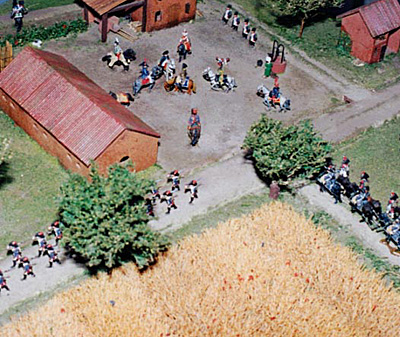 The Austrian forces spread across Northern Italy concentrated rapidly in response to Bonaparte's irruption over the Alps. By 13 June, 1800 Field Marshal Melas had some 31,000 men and 100 guns assembled at Alessandria. The next day he would attempt to punch through the relatively dispersed French forces to the east and restore his communications with the homeland.
The Austrian forces spread across Northern Italy concentrated rapidly in response to Bonaparte's irruption over the Alps. By 13 June, 1800 Field Marshal Melas had some 31,000 men and 100 guns assembled at Alessandria. The next day he would attempt to punch through the relatively dispersed French forces to the east and restore his communications with the homeland.
Diorama in Marengo Museum: Bonaparte's staff and French reserves on the march.
The Battle of Marengo merits detailed study, and the reader is encouraged to consult the available sources (see Bibliography). A brief chronology may help orient the visitor:
14 June, 1800
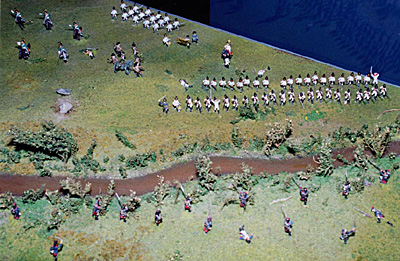
0800: The Austrian Right (O'Reilly, 3,000 men) and Center (Melas, 20,000) launch a massive attack from their bridgehead on the Bormida River, driving in the French outposts.
Diorama: French resistance along the Fontanone creek.
0800-1200: Victor's Corps (10,000), outnumbered and outgunned, take position along the Fontanone creek and in the village of Marengo, fighting off several Austrian attacks.
1200: The Austrian Left (Ott, 7,600) advances on Castel Ceriolo to turn the French right flank. Monnier's Division and the Consular Guard resist but are gradually driven east of Castel Ceriolo.
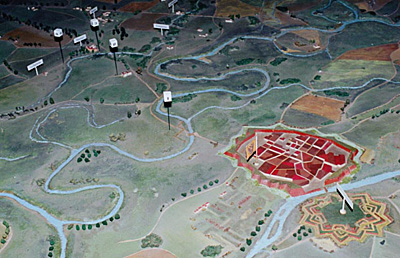 1400: The French retreat eastward from Marengo.
1400: The French retreat eastward from Marengo.
Relief map: looking east over Alessandria toward Marengo.
1500: Field Marshal Melas, believing the French to be irrevocably defeated, leaves the field and entrusts command of the Austrian pursuit to General Zach.
1630: General Desaix, at the head of Boudet's Division, arrives on the field after a forced march from the south. The French rally west of San Giuliano.
1700: General Desaix is killed leading the counterattack against Zach's pursuing column.
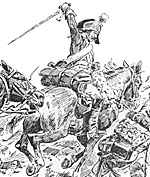 Kellermann's cavalry launch a perfectly timed charge against Zach's left flank. The Austrians are routed and retreat in disorder to Alessandria.
Kellermann's cavalry launch a perfectly timed charge against Zach's left flank. The Austrians are routed and retreat in disorder to Alessandria.
"The Charge of Kellermann's Cavalry," by Maurice Toussaint. From Tranie & Carmagniani, La Deuxieme Campagne d'Italie, p. 228.
15 June, 1800
Field Marshal Melas signs the Convention of Alessandria, surrendering Northern Italy west of the Chiesa River.
The Citadel of Alessandria still squats grimly on the west edge of the town. We spared it only a passing glance in our eagerness to get to the hallowed ground to the east. Leaving central Alessandria by Route S10 (direction Tortona), one quickly crosses over the Bormida River, now much straightened from the sinuous course it followed in 1800.
 About 2 km east of the bridge, slightly forlorn on an island surrounded by whizzing traffic, stands the eagle-topped column erected on the order of Napoleon himself here at the west edge of Marengo village. Raised on the first anniversary of the battle in June 1801, the column was thrown down by vengeful Austrians in 1814 and re-erected by the Italian Army in 1918.
About 2 km east of the bridge, slightly forlorn on an island surrounded by whizzing traffic, stands the eagle-topped column erected on the order of Napoleon himself here at the west edge of Marengo village. Raised on the first anniversary of the battle in June 1801, the column was thrown down by vengeful Austrians in 1814 and re-erected by the Italian Army in 1918.
The Marengo Column. Inscription: HIC PROPE MARENGUM XVIII KAL. JUL. ANNO MDCCC BONAPARTE PRIMO CONSOLE GALLICAE REPUBLICUS EXERCITUS DUCE VICTORIA PARTA.
The column stands roughly in the center of the position in which Victor's Corps withstood six hours of Austrian attacks before retreating under the pressure of superior numbers around 1400 on 14 June, 1800.
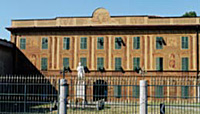 Opposite the column on the north side of S10 stands the Marengo Museum (at left). In spite of the rather strange "trompe l'oeil" facade, this museum is a gem. It features a huge and highly informative relief map of the battlefield, beautiful dioramas, a small but interesting collection of arms and equipment recovered from the area, and commemorative statuary. The staff is friendly and knowledgeable, though a command of French or Italian will ease communication.
Opposite the column on the north side of S10 stands the Marengo Museum (at left). In spite of the rather strange "trompe l'oeil" facade, this museum is a gem. It features a huge and highly informative relief map of the battlefield, beautiful dioramas, a small but interesting collection of arms and equipment recovered from the area, and commemorative statuary. The staff is friendly and knowledgeable, though a command of French or Italian will ease communication.
In July 1999, they directed us to a splendid bicentennial reenactment of the Battle of Novi that was taking place that same afternoon, featuring Marengo's own Napoleonic reenactment group, the Prima Battaglione Italiana. In the park adjoining the museum is a memorial to General Desaix and an ossuary containing the remains of some of the fallen.
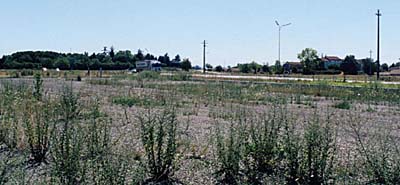 The surrounding battle area is innocent of markers or memorials, requiring the visitor to be equipped with a good map, reference books, and imagination.
The surrounding battle area is innocent of markers or memorials, requiring the visitor to be equipped with a good map, reference books, and imagination.
The east edge of modern Castel Ceriolo, looking west from the approximate position of Monnier's division during the afternoon fighting. Ott's Austrians attacked eastward out of the village.
The terrain is described in one of my references (Tranie and Carmagniani, Napoleon Bonaparte: La Deuxieme Campagne d'Italie 1800, p.207) as having "numerous fences, irrigation ditches, paths, and many farmsteads with massive buildings suitable for strongpoints."
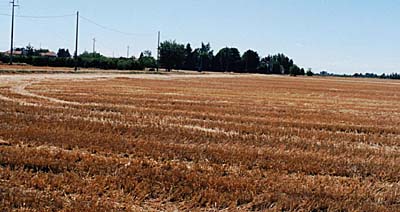 However, to a modern eye it appears there could be few places in Western Europe more flat, open, and suitable for the untrammeled operation of cavalry.
However, to a modern eye it appears there could be few places in Western Europe more flat, open, and suitable for the untrammeled operation of cavalry.
The fields north of the San Giuliano-Marengo road, looking west from the edge of San Giuliano. Kellermann's cavalry charge angled from right to left across these fields to hit the flank of Zach's column on the road (behind the trees on the left).
The French may have been fortunate indeed that Melas had detached an entire brigade of cavalry on a useless mission to the south, leaving only 5200 sabers (instead of 7500) available on the day of battle. French cavalry strength is estimated at 3700.
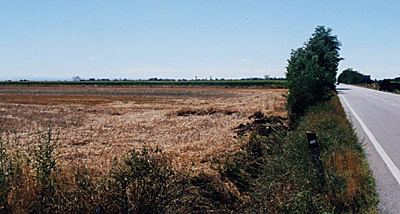 Both Marengo and Castel Ceriolo have grown considerably since 1800, in both cases spreading mostly to the east. San Giuliano is now known as San Giuliano Vecchio (the old) to distinguish it from San Giuliano Nuovo, a village several kilometers to the north that did not exist in 1800.
Both Marengo and Castel Ceriolo have grown considerably since 1800, in both cases spreading mostly to the east. San Giuliano is now known as San Giuliano Vecchio (the old) to distinguish it from San Giuliano Nuovo, a village several kilometers to the north that did not exist in 1800.
Looking west along the San Giuliano-Marengo road at the site of Desaix's counterattack and death.
There astride the arrow-straight road where Zach's pursuing column came to grief is a good spot to contemplate the hinge of fate: What would have become of Napoleon Bonaparte if the last-ditch counterattack had failed?
The Battle of Marengo, controversial for the errors that led to the brink of defeat and for Napoleon's subsequent editing of accounts to burnish his reputation, was a cardinal event politically as well as militarily:
- "The day of Marengo will remain famous throughout History," declared the First Consul. He was right; it was his first victory as head of state, and many authorities regard the Marengo Campaign as the beginning of his period of full greatness, both civil and military.
Bibliography
Chandler, David G. The Campaigns of Napoleon. Weidenfeld & Nicolson, London, 1966.
Chandler, David G. Dictionary of the Napoleonic Wars. Simon & Schuster, New York, 1993.
Chandler, David G. (ed.) Napoleon's Marshals. Weidenfeld & Nicolson, London, 1987.
Griess, Thomas E. Atlas for the Wars of Napoleon. Avery, Wayne, NJ, 1986.
Tranie, Jean et J.C. Carmigniani. Napoleon Bonaparte: La Deuxieme Campagne d'Italie, 1800. Pygmalion, Paris, 1991.
Chappet, Alain, Roger Martin, Alain Pigeard et Andre Robe. Repertoire Mondial des Souvenirs Napoleoniens. S.P.M., Paris, 1993.
Recommended
Arnold, James R. Marengo and Hohenlinden: Napoleon's Rise to Power. Napoleon Books, VA, 1999.
MagWeb.com One-Drous Chapter: Marengo and Hohenlinden: Napoleon's Rise to Power Chapter VII: The Battle of Marengo
MagWeb.com Book Review: Marengo and Hohenlinden by James Arnold
E-mail at: Marengo and Hohenlinden info or go to the website: www.napoleonbooks.com
More Marengo
-
Marengo: Introduction
Marengo: Great St. Bernard Pass
Marengo: Fort Bard
Marengo: The Battlefield
Marengo: Jumbo Battlefield Maps (very slow: 256K)
Back to List of Battlefields
Back to Travel Master List
Back to MagWeb Master List of Magazines
© Copyright 2000 by Bill Peterson.
This article appears in MagWeb (Magazine Web) on the Internet World Wide Web.
Other military history articles and gaming articles are available at http://www.magweb.com